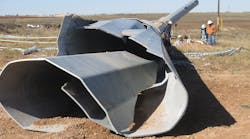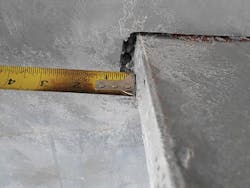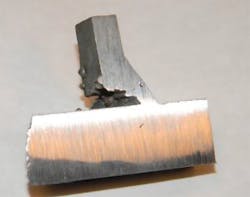Function or Failure: Welded Connections in Transmission Structures
A tubular steel transmission pole generally consists of a series of welded assemblies. The pole shafts and arms are folded plates with seams joining the edges of the steel plates. The resulting tubular steel shafts then can be welded to flanges or other brackets to join them together. Insulators generally are attached to some type of plate welded to the ends of arms or pole shafts. The challenge with the assemblies that make up a typical tubular steel pole is that many of the welded connections have virtually no structural redundancy.
Stated another way, the welded connections either will functionally perform as designed or be at risk of catastrophic failure. Picture, for example, the failure of a typical davit arm shaft-to-bracket weld or a pole shaft-to-base plate weld. These types of welds commonly are referred to by the welding community as fracture-critical welds. For this reason, welding these types of connections is the single most significant quality element in the manufacturing of steel transmission pole assemblies. Welding also is one of the least understood elements of steel pole fabrication by most utility engineers.
The American Welding Society (AWS) D1.1 Structural Welding Code‒Steel, is used most commonly by specifiers and fabricators of tapered tubular steel poles for their various welded connections and attachments. Because all welded joints are connections of steel parts, it is essential requirements of AWS D1.1 code, or other specified codes and requirements, be followed diligently during the welding of tubular steel pole assemblies.
Because welding is both an art and a science, it can be challenging to achieve consistently high-quality welds in tubular steel poles. Eight criteria typically define the most common challenges in producing high-quality welds in steel transmission pole structures.
The Challenges
The personnel who are performing the welding must be properly qualified and certified for the welding processes and positions required for the job. Four primary welding positions are used by welders when welding connections on tubular steel poles. In order of increasing difficulty, they are flat (F), horizontal (H), vertical (V) and overhead (OH).
The skill required of the individual welder increases as the difficulty of the position changes. Most steel pole shop welders typically are tested and qualified or certified in either the flat or horizontal position, or both. Attempting to weld in the vertical or overhead position, if not properly qualified or certified to do so, would be a violation of AWS D1.1 Welding Code.
Also important to the quality of a welded connection is the welding process selected by the pole fabricator. AWS D1.1 recognizes four major welding processes:
- Shielded metal arc welding (SMAW)
- Gas metal arc welding (GMAW)
- Submerged arc welding (SAW)
- Flux cored arc welding (FCAW).
All four of these welding processes are used to varying degrees in the fabrication of tapered tubular steel poles. For shop-welded connections on tapered tubular steel poles, the two more commonly used welding processes are FCAW and, more recently, GMAW. Both have unique advantages and disadvantages that must be considered.
Another important criterion of a quality weld, particularly for the fracture-critical welds that comprise most steel pole connections, is ensuring the weld joint has been fit up properly for welding. Joint tolerances are provided in AWS D1.1 or a weld procedure specification (WPS) for root opening, bevel angles and weld cap size, among others. All such tolerances need to be followed carefully during joint fit-up and welding.
It is an AWS D1.1 requirement to prepare a highly specific WPS for welding any joint. Additionally, a procedure qualification record (PQR) will help to ensure the welded connection has the mechanical strength, ductility and, if specified, charpy toughness characteristics intended and necessary for the welded joint.
As stated earlier, welds are a dilution and combination of the base metals with the addition of a filler metal (the welding rod or wire). If a WPS is qualified properly for use based on certain mechanical or chemical properties of the base metals, or welding rod or wire, any significant variance of those mechanical properties can result in a change of actual performance of the welded joint. For example, the welding of a connection that has base metals with a significantly higher ultimate tensile strength or higher carbon equivalency than the plates used to weld a sample test for the procedure qualification records (PQR) could lead to significant changes in the ultimate performance of the weld. In turn, this could potentially lead to weld failure.
Joint distortion is another challenge related to welding steel pole connections. It is important to the integrity of the welded joint to consider and anticipate the distortion caused by the heat input of the welding process. Not doing so in highly restrained and constrained welded connections can create very high residual tensile stresses and potentially lead to weld cracking. The more highly constrained the weldment, the higher the residual tensile stress on the weld as it cools and shrinks.
Monitoring preheat, heat input during welding, interpass temperatures and post-weld cooldown temperatures is an important consideration when welding the high-strength, low-alloy steels commonly used in steel pole connections. Such criteria are important because all those aspects influence the cooling rate of the weld as it solidifies. Cooling too fast may result in undesirable effects on the mechanical properties and metallurgical structure of the deposited weld and the heat-affected zone (HAZ).
Other than notch toughness, the mechanical properties of the steels being welded either will increase or decrease with increasing heat input. However, notch toughness has been found to increase slightly and then drop significantly as heat input from welding increases.
Inspections are Critical
The ability to inspect certain welded steel pole connections often is not given the consideration it should be to ensure quality welds are achieved. Different types of welds and welded joints require different types of inspections. For complete joint penetration (CJP) welds, it is expected 100% fusion of the plates in the joint will be achieved. Typically, CJP welds are performed with either backing bars or backing welds, along with a prescribed root gap, to ensure complete penetration of the joint is achieved.
Inspection requirements from the American Society of Civil Engineers (ASCE), in the 48-11 Design of Steel Transmission Pole Structures standard, call for CJP welds to be 100% inspected by either ultrasonic (UT) or radiographic (RT) methods. The standard also states, “For galvanized members with large ‘T-Joint’ connections, such as base plates, flange plates, etc., ultrasonic examination shall be performed on 100% of all such joints, not only before but after galvanizing to ensure that no cracks have developed.”
AWS D1.1 generally only requires partial joint penetration (PJP) welds to be inspected visually for workmanship-related deficiencies (weld size, profile, undercut, porosity, overlap) or surface defects like centerline cracking. However, it is extremely difficult, if not impossible, to see out-of-tolerance joint fit-up or deficient joint penetration that may be occurring on a PJP weld if it is on the interior of an arm or pole shaft once the connection is fully welded.
Hot-Dipped Galvanizing
A final significant challenge is the effect of hot-dipped galvanizing on tubular steel pole connections (particularly large T-joints as is the case with base plate-to-pole shaft or flange plate-to-pole shaft connections). This issue is well documented but not necessarily fully appreciated by many performing welding on steel pole connections. It is an issue that requires much attention to detail, both during welding and after galvanizing.
HAZ toe cracks can develop within certain welded connections because of the various residual stresses developed on these connections during welding as well as during and following the thermal gradients associated with hot-dipped galvanizing. Hydrogen from the pickling acids (hydrochloric acid and sulfuric acid) used to clean the steel can tend to infuse into the steel and welds during the cleaning, or pickling, process. As a result, hydrogen-induced cracking (HIC), also referred to as hydrogen assisted cracking (HAC), can occur on the welds and in the HAZ. However, if close attention to several important welding details are monitored and managed carefully, welded connections on steel poles with a hot-dipped galvanized finish can perform well and provide excellent long-term structural reliability.
Thorough Understanding
Significant challenges exist in ensuring good-quality welds are realized in typical welded connections used on steel transmission pole structures. Most of the challenges can be minimized by simply paying close attention to the well-defined requirements defined in the codes and standards for the industry.
Remember: Welding is both an art and a science. As such, high quality depends on the skill of those performing the task of fit-up, welding and inspecting of the connections for steel pole structures. It also is important to remember welds can only be as good as the materials they are joining. It is crucial to pay attention to the quality and specification of the materials used in these connections.
A thorough understanding as well as continuous monitoring of the challenges and criteria identified will certainly help to ensure steel transmission poles, fabricated and installed to support the power grid, will perform reliably within the challenging environmental and loading conditions these structures must endure.
Jim Merrill, PE, received a bachelor’s degree from the College of Engineering in welding at Utah State University in 1985. A registered professional engineer in the states of Texas and California, he has been an American Welding Society (AWS) certified weld inspector since 1986. He is a member of the AWS D1 main committee as well as several AWS D1 subcommittees, including the committee for welding inspection.
Wesley Oliphant, PE, received a BSCE degree from Texas A&M University in 1974 and MBA degree from the University of Houston in 1986. He is a registered professional engineer in Texas, a Fellow of the American Society of Civil Engineers and Structural Engineering Institute, as well as an American Welding Society certified weld inspector.




